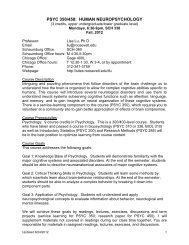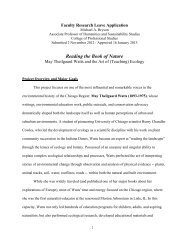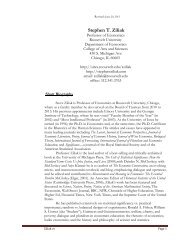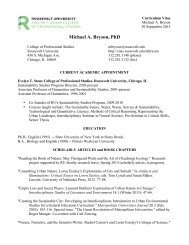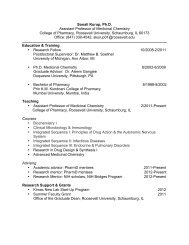Social Insurance and Public Assistance
public-assistance-welfare-reform-colonial-times-to-the-present-ziliak ...
public-assistance-welfare-reform-colonial-times-to-the-present-ziliak ...
You also want an ePaper? Increase the reach of your titles
YUMPU automatically turns print PDFs into web optimized ePapers that Google loves.
696 Bf SOCIAL INSURANCE AND PUBLIC ASSISTANCE<br />
TABLE Bf-A Important legislation <strong>and</strong> events affecting social welfare policy: 1601–1997 Continued<br />
1917 First state department of public welfare established in Illinois to increase state financing <strong>and</strong> control of public assistance. Other<br />
states developed public welfare departments in the 1920s.<br />
1920 Civil Service Retirement Act. Established a regular system of pensions for all federal government employees.<br />
1920 State–federal rehabilitation programs first enacted under the Smith–Fess Act.<br />
1921 Shephard–Towner Act passed to provide federal grants to states to improve public health programs. Program ended by 1930.<br />
1932 Reconstruction Finance Corporation established. Among its many tasks, the RFC made loans to local governments to help<br />
finance public assistance <strong>and</strong> work relief.<br />
1932 First state unemployment insurance law passed by Wisconsin, but no benefits were paid before the <strong>Social</strong> Security Act<br />
established the state–federal program in 1935.<br />
1933 New Deal programs began providing emergency funding for work relief <strong>and</strong> direct relief of the unemployed.<br />
1934 Federal Railroad Retirement pension program enacted. Declared unconstitutional <strong>and</strong> replaced by new law in 1935.<br />
1935 First federal public housing project begins construction under the <strong>Public</strong> Works Administration’s <strong>Public</strong> Housing program.<br />
1935 <strong>Social</strong> Security Act passed. The Act established the Old-Age, Survivors <strong>Insurance</strong> pension program <strong>and</strong> set up state–federal<br />
programs for unemployment insurance, old-age assistance, aid to the blind, <strong>and</strong> aid to dependent children.<br />
1936 Veterans’ bonus of up to $2 billion paid to World War I veterans.<br />
1937 U.S. Housing Authority established to aid in the building of public housing.<br />
1938 Federal Railroad Unemployment <strong>Insurance</strong> program enacted.<br />
1939 <strong>Social</strong> Security Act amended to make the Old-Age, Survivors <strong>Insurance</strong> program a pay-as-you-go system in which current tax<br />
revenues fund payments to <strong>Social</strong> Security pension recipients.<br />
1940 First <strong>Social</strong> Security Old-Age <strong>Insurance</strong> pension checks issued.<br />
1946 Federal Railroad Disability <strong>Insurance</strong> program enacted.<br />
1950 Farm <strong>and</strong> domestic employees <strong>and</strong> nonfarm self-employed persons are covered for first time under <strong>Social</strong> Security Old-Age<br />
<strong>Insurance</strong> pension program.<br />
1950 Federal government establishes program to fund payments to medical vendors for care of low-income persons.<br />
1950 <strong>Social</strong> Security Act amended to provide aid to the totally <strong>and</strong> permanently disabled.<br />
1954 Self-employed farmers covered under <strong>Social</strong> Security pension program.<br />
1959 First payments made under <strong>Social</strong> Security Disability <strong>Insurance</strong> program.<br />
1960 Federal government initiated a program for medical assistance to the elderly.<br />
1962 Aid to Families with Dependent Children (AFDC) superseded the aid to dependent children program as coverage exp<strong>and</strong>s to<br />
include adults caring for dependent children.<br />
1962 First year that Food Stamps are provided for low-income persons under pilot program. First Food Stamp Act was passed in 1964.<br />
1962 Manpower Development <strong>and</strong> Training Act along with the Equal Opportunity Act of 1964 established work-experience training<br />
programs.<br />
1965 Legislation established the U.S. Department of Housing <strong>and</strong> Urban Administration.<br />
1965 Medicaid program established to build upon <strong>and</strong> take over earlier programs for paying vendors for the provision of medical care<br />
to persons with low incomes.<br />
1965 Medicare established to offer federal health insurance for the elderly.<br />
1965 Omnibus Budget <strong>and</strong> Reconciliation Act (OBRA) homogenized resource limits across states <strong>and</strong> increased the AFDC benefit<br />
reduction rate to 100 percent.<br />
1969 Black Lung Benefits program established by the federal government to provide disability payments to miners with black lung<br />
disease.<br />
1969 Federal government established an emergency assistance program.<br />
1972 Supplemental Security Income program superseded the old-age assistance, aid to the blind, <strong>and</strong> disability programs.<br />
1972 The Women, Infants <strong>and</strong> Children program for nutritional supplementation was started as a pilot program <strong>and</strong> became<br />
permanent in 1974.<br />
1973 Congress passed the Comprehensive Education <strong>and</strong> Training Act to replace earlier job training programs <strong>and</strong> to provide block<br />
grants for decentralized training.<br />
1981 Low-Income Home Energy <strong>Assistance</strong> Program established to provide block grants to help low-income households meet their<br />
energy expenses.<br />
1983 Job Training Partnership Act replaced Comprehensive Education <strong>and</strong> Training Act. Private industry councils work with county<br />
welfare agents to connect welfare-to-work with wage subsidies.<br />
1987 Federal Employees Retirement System (FERS) established. The FERS offered a broader range of retirement benefits than the<br />
original Civil Service Retirement System.<br />
1988 Family Support Act. Attempted to change welfare programs from eligibility <strong>and</strong> monitoring programs to explicit programs for<br />
moving households into self-sufficiency. Child support laws were strengthened, <strong>and</strong> work was required from most of the<br />
able-bodied.<br />
1996 Personal Responsibility <strong>and</strong> Work Opportunity Reconciliation Act. The Act removed the federal control of public assistance that<br />
had been enabled by the <strong>Social</strong> Security Act of 1935 <strong>and</strong> strengthened by amendments in 1962. In particular, the individual<br />
states were no longer required to provide a poor person with a cash welfare benefit.<br />
1997 Temporary <strong>Assistance</strong> for Needy Families program (TANF) replaced the AFDC program. TANF was by 1998 operating in about<br />
forty states. Each state is enforcing a four- or five-year lifetime limit on the receipt of cash benefits <strong>and</strong> requiring (however<br />
differently) some amount of waged employment from drug-free participants.



